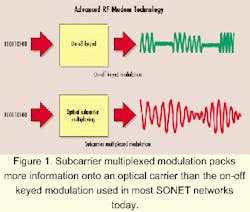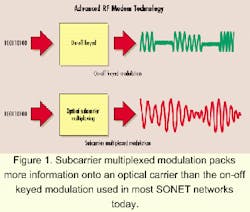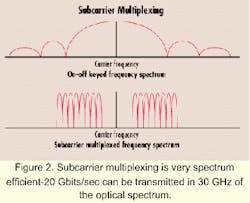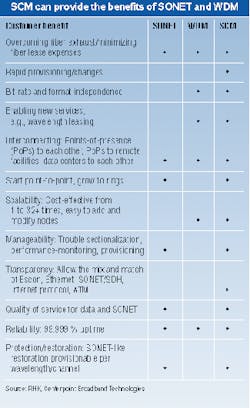Optical subcarrier multiplexing squeezes more capacity from bandwidth
Ted Wolcott and Eric Schmidt
Centerpoint Broadband Technologies
The rise in Internet use for businesses and consumers is driving global demand for more bandwidth. Data traffic is increasing 400% per year and has already surpassed voice traffic. Broadband services, "always-on" connections, and longer-distance delivery are fueling this data growth. The increasing traffic is straining the existing infrastructure and will only worsen for carriers that try "more-of-the-same" network expansion.
With demand for data outpacing technology advancement, the time has come for a new generation of advanced optical-transport technology that provides higher capacities for both single-wavelength and multiwavelength systems, reduces the cost per bit for transport, and is compatible with traditional Synchronous Optical Network (SONET) equipment. With seemingly "infinite" bandwidth in fiber networks, there wasn't a need for advancements in core modulation technique-until now. Optical subcarrier multiplexing, a modulation technique that is available today and has a proven history in cable-TV distribution and satellite systems, can improve the band-width efficiency of existing and future networks.
SONET-based solutions have provided a solid, standardized telecommunications infrastructure, enabling the reliable global communication the world has come to expect. SONET technology is continually evolving to meet the high-capacity transport required by the rapid growth of voice and data network traffic. Current systems operate at rates of up to 10- Gbit/sec (OC-192); next-generation systems will support 40-Gbit/sec (OC-768). Unfortunately, these on-off-keyed (OOK) solutions offer high transport capacity at a cost-in dollars, complexity, inflexibility, and bandwidth inefficiency.
Dense wavelength-division multiplexing (DWDM) is the current technology that allows fiber to carry the greatest amount of information; it is used primarily in backbone networks. However, DWDM alone is not a complete solution for carriers who need flexible, manageable systems. Much more can be done to increase the capacity and manageability of each DWDM channel.SONET and DWDM combined give service providers capacity and manageability at a high price in terms of overhead, capital cost, and operational expenses. This penalty only increases as networks continue to shift from circuit to data traffic.
Although SONET and DWDM have served the telecommunications industry well, as traffic grows exponentially and revenues only increase linearly, operators cannot afford to keep doing more of the same. What worked for long haul does not meet the needs of the increasingly data-centric metro environment. In the metro environment, operators will need to deliver services quickly, easily, and at a fraction of the cost.
Optical-communications networks are feeling the bandwidth constraints already faced in many other communications networks. Demands for increased capacity over copper wires to the home and business forced the development of new technologies such as digital subscriber line (xDSL). As the Federal Communications Commission has sliced and diced the radio-frequency (RF) spectrum, wireless and satellite communication systems have evolved to maximize the amount of information transmitted in very narrow channels. Even computer disk drives can be viewed as communication technology that has undergone advancement to meet accelerating demands for faster access with increased capacity.
$$$$$$Until recently, the field of optical communications was unencumbered by such bandwidth limitations. The optical channel is vast in comparison to other communication channels. Today's fiber-optic networks use the bandwidth-inefficient OOK modulation. When fiber-optic capacity limitations weren't really an issue, high-bandwidth efficiency was unnecessary and unattractive when compared to the simple and inexpensive OOK techniques. Therefore, advancements in communication technology were focused elsewhere. This situation has changed, because ever-increasing data rates means building devices that can operate at rates higher than 10 Gbits/sec-not only challenging, but very expensive.
The time has come for optical-communications technology to follow in the footsteps of more mature communications fields. Advanced modulation techniques increase bandwidth efficiency and lower the operating rate of the electronics. Forward error correction decreases the optical power necessary to close the link.Distortion mitigation techniques improve signal quality at the receiver, decreasing distortions found in nonlinear fiber channels. These technologies were pioneered in the fields of wireless, satellite, and copper cable communication fields-and they can all be performed with proven digital circuitry without driving up costs. Out of necessity, optical transmission technology must evolve to take advantage of these advancements.
Optical subcarrier multiplexing (SCM), also referred to as optical frequency-division multiplexing (FDM), offers many advantages over traditional SONET multiplexing techniques, such as greater capacity in the same bandwidth and increased network flexibility. Advanced RF modem technology creates these advantages by efficiently using the available channel spectrum (see Figure 1).
SCM "channelizes" the available spectrum, using a different frequency band to carry each channel. In comparison, SONET time-division multiplexing (TDM) bursts the data for each channel during short time slots, assigning one time slot per channel. As a result, TDM circuits operate at the combined data rate of all channels, while each SCM circuit operates only at the individual channel data rate.
$$$$$$$Stacking multiple RF subcarrier channels in the available bandwidth and using highly efficient modulation techniques increases capacity without a corresponding increase in required bandwidth or clock speed. For example, 20 Gbits/sec can be transmitted in ~30 GHz of optical spectrum, while an equivalent SONET TDM system would require 40 GHz (see Figure 2).
Partitioning fiber capacity in frequency instead of time yields a much more flexible system. TDM systems require each tributary channel to operate at very precise rates. SCM systems transmit multiple channels-each carrying traffic and operating at different rates-such as SONET channels intermixed with Fibre Channel or Gigabit Ethernet channels. This feature eliminates the need for equipment to convert non-SONET signals into SONET signals.SCM has been employed at lower data rates for years in the field of cable-TV distribution and satellite systems. Cable- and satellite-TV systems have faced capacity constraints similar to those that fiber systems will en-counter in the near future. The current cable plant was deployed over the past 20 years and had tremendous bandwidth compared to what was initially needed for over-the-air broadcasting. As users began to demand broadband services like pay-per-view movies, the system operators had more programming than the cable plant could support. Cable operators elected to blend digital programming using 64- and 256-quadrature amplitude modulation (QAM) with their conventional amplitude-modulation (AM) broadcasts. In this way, the plant could support new services with modest investment. This upgrade investment can be made incrementally and will scale with increased traffic and revenue.
Direct broadcast satellite (DBS) pro-viders leveraged QAM to leapfrog over terrestrial broadcasters to offer all basic and pay-per-view channels digitally. Having "new plant" and limited (radio) spectrum, it made sense to optimize the system for the most programming at the lowest cost. Similarly, cable modems today use advanced modulation techniques, which allows operators to increase the number of users on the cable plant.
Packet-based optical networks can deploy SCM as a way to offer new services and dramatically increase the carrying capacity of the existing network. Optical SCM technology is a simple solution to network migration that has attracted the attention of many competitive local-exchange carriers, incumbent local-exchange carriers, and interexchange carriers. Recent breakthroughs in application-specific integrated-circuit and optical technology make high-capacity transport systems economically compelling for multigigabit telecommunications systems.
Optical SCM technology is well suited to the needs of next-generation optical networks. The technology also works over existing networks, moving a tremendous volume of information using low-speed components. SCM complements SONET and DWDM systems and can be deployed over existing singlemode-fiber hops.
Optical SCM offers the benefits of both SONET and WDM in a low-cost, high-density network element (see Table). As networks move from circuit to packet architectures, SCM chipsets offer SONET protection for SONET tributaries and SONET-like protection for non-SONET tributaries. Like SONET, SCM systems can be configured for terminal and add/drop mode. All channels are available at all nodes.
With the adoption of this technology, the network-management system tracks one system, end-to-end, with many electronic subcarriers. This monitoring can be done more easily than the management of multiple strands of glass or independent wavelengths.
SCM increases the information content of each pulse, dramatically boosting the capacity of the existing network infrastructure. All channels remain independent in time, allowing a mix of protocols and data rates. Individual subcarrier channels can be sold to users to create virtual networks.
SCM puts traffic on one channel at a time, offering a very low initial cost and tremendous scalability. It can be reconfigured as network demands change. For example, a voice-based network can be gradually reconfigured for data. This technology can smooth the transition from circuit to packet transport. SCM offers the flexibility and scalability needed to meet the capacity demands of tomorrow's networks, making optical networks lightwave efficient.
Ted Wolcott has served as chief engineer for Centerpoint Broadband Technologies Inc. (San Jose, CA) since the company's founding in early 1999. He has directed the development of the company's core technology for optical transport systems. Eric Schmidt is director of business development at Centerpoint.



